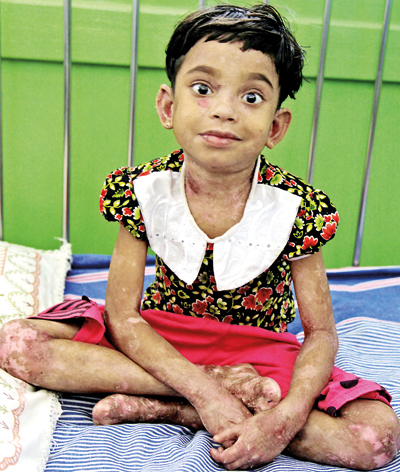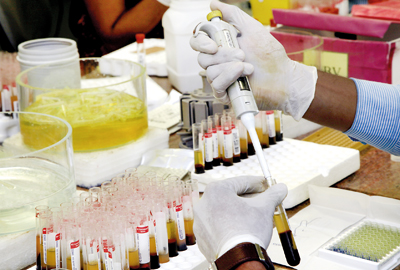No more the agony of terrible blisters
The parents are elated at the birth of a baby, only to face great sadness and despair over the heart-wrenching agony soon after. The agony is not limited to them but encompasses the child and the doctors, not only in Sri Lanka but worldwide, for there has been no treatment for this ‘blister disease’ till now.
 Dr. Hewage |
 Prof. Seneviratne |
Not in a highly-funded laboratory with state-of-the-art equipment abroad but in the simple but very efficient setting of the Skin Clinic of the Lady Ridgeway Hospital (LRH) for Children in Colombo, a dedicated medical team headed by Consultant Dermatologist, Prof. Jayamini Seneviratne, has found an answer for the severe blistering in Epidermolysis Bullosa (EB).
This trailblazing team has found an answer to a serious skin disease which has baffled doctors for decades, putting tiny Sri Lanka on the map for skin research as well as alleviating the agony of the victims and the trauma of the family. For EB ends in serious infections and finally death, while when the child is alive there is much stigma attached to it.
EB is a group of rare, inherited skin disorders that cause the skin to become very fragile. Any trauma or friction to the skin can cause painful blisters. EB literally makes the skin fall off.
The three children in Ward 19 of the LRH brought into focus the suffering of those who fall victim to this disease but are now overcoming the blistering due to this treatment breakthrough. (See box for their stories)
It all starts with a blister that a newborn develops soon after coming into the world, the Sunday Times learns. As the parents assume it is nothing serious, the repercussions come rapidly. The single blister, the first indication of EB then spreads with rapid and determined intensity.
“Although it is a rare condition, affecting 19.6 per one million live births, there is tremendous suffering,” points out Prof. Seneviratne.
Grouping EB according to the place in the various layers of skin the blistering takes place, Prof. Seneviratne says they are EB simplex (the blistering occurs in the upper layer of the skin — the epidermis); Junctional EB (the blistering occurs at the junction between the epidermis and the dermis, known as the basement membrane zone); and Dystrophic EB (the blistering occurs below the basement membrane zone in the upper part of the dermis).

“It’s better now,” smiles Renushika. (Photographed with her mother’s consent). Pix by M.A. Pushpa Kumara
“The blisters could be caused spontaneously or due to trauma, followed by erosion, crusted lesions and severe infections,” explains Prof. Seneviratne picking out the most dangerous form of EB which is Dystrophic EB.
This results in severe scarring and nail loss, pseudosyndactily and in the latter stages cell carcinoma, says Prof. Seneviratne, allowing all types of infections to attack the body. By the time a victim of EB becomes an adult of 20 or 30 they are prone to severe cancers, with the body’s repair process being weakened, resulting in death. “We were just treating the symptoms with antibiotics and wound care.”
There is much research with regard to gene therapy, replacement therapy and cell-based therapy but, according to Prof. Seneviratne, EB is an “orphan disease” and not many are interested in finding a solution as research these days focuses only on common diseases which bring in a lot of money, not rare ones such as this.
Explaining that a few attempts are being made in other countries to try out cell-based therapy in the form of injected fibroblast (autologous and allogenic), allogenic bone marrow graft and revertant stem-cell therapy from uninvolved skin, Prof. Seneviratne said two of five children who underwent the graft procedure had died while there has been no clinical benefits from the last therapy.
It was because there was no single optimum therapy for EB that he wracked his brains whenever a victim turned up at the clinic. Looking at them closely, he realised that though their bodies were covered with blisters and wounds, their heads had escaped the disease.
Six months ago, the Sunday Times understands, it dawned on Prof. Seneviratne and his team that as hair follicles undergo mitosis daily to form hair, the stem cells in those may be useful in treating the blisters. It was thereafter that they launched their research, after seeking permission from the parents to perform the “autologous stem-cell transfer” (ASCT) on six children.
Going into the details of this brand-new concept, Prof. Seneviratne says that the team used the diseased, stem-cell depleted left side of each child’s body for treatment, by transferring the patient’s stem cells from a relatively disease-free but stem-cell rich area (hair follicles). The diseased right side was used as a control. A series of photographs also documented not only the procedure but also the severity before the stem-cell procedure and the results after.
While the conclusions are clear that ASCT is the “most effective short-term treatment available in the prevention of blistering”, though it’s a slow process, it is relatively safe and non-invasive, he says, adding that it improves the quality of life.
With LRH Director Dr. R. Hewage adding not only his voice but also his wholehearted support for the research, Prof. Seneviratne says that the “cost is minimal and the treatment can be performed in any developing country”.

The other team members (from left) Ms. K.G. Kusumawathi, Ms. A.J. Zoysa, Ms. K.L. Pushpamala, Dr. (Ms) M.K.D. Tissera, R.A.D.K.D. Shiranthi and Dr. (Ms) R. Seneviratne
This research opens a wide window in the future as hair follicle stem cells can now be used on burn victims and those with vitiligo.
For Prof. Seneviratne, apart from the praise that is forthcoming from his colleagues and the Health Ministry, the biggest satisfaction comes when a mother whose child has undergone the treatment walks into the Skin Clinic with a big smile wreathing her face.
Cornered by society, now they have hope
The tales of trauma and stigma are the same but no less heart-rending. Whether it is six-plus Renushika from Kuliyapitiya, three-plus Eekshana from Wadduwa or 12-year-old Ranuka from Baddegama, from the day they were born, there has been only illness and misery, not only for them but also for their families.
The terrible blisters that would form all over their bodies would break open and fester, with germs entering at will, causing severe itching and a foul smell.
Renushika was the first to undergo this new treatment, says mother Achala Fernando, adding that from the time of her birth there was no sleep for her as well as for the parents. Showing us how her little girl’s toes have got pasted together after the peeling of the skin, Achala is quick to point out the areas which have been under treatment and have got cleared well.
Eekshana who is sleeping soundly in his cot at the LRH would constantly cry, his mother Kusum said. “We were cornered by society because whenever he went to play, there was a bad smell coming from him,” she says unable to hold back the sobs wracking her body.
Whenever Ranuka got up from bed, there was a layer of skin. When he removed his socks, the skin used to come off with them, says his mother, adding that now, however, there is hope of a normal life for these children.
These impoverished parents are barely able to feed their families and this illness has pushed them further into an abyss of poverty.
While Ranuka’s mother spends time at his bedside, she has heard that his father has left his job after falling ill. Meanwhile, Renushika’s father is a labourer toiling back home to keep the family from starving.
Please help
Generous donors could help them by contributing their mite to Ranuka’s mother J.K. Kusuma’s account 8980017007 at the Baddegama Commercial Bank; Renushika’s mother Achala Fernando’s account 71397786 at the Dankotuwa Bank of Ceylon; and Eekshan’s mother K.P. Wijesinghe’s account 3742917 at the Wadduwa Bank of Ceylon.
LRH needs a tissue lab
When a lot of hair of a child has to be pulled out there is pain, so to gain success with this new treatment, Prof. Jayamini Seneviratne’s plea is simple – Give the LRH a tissue laboratory to grow adequate numbers of stem cells from a few hair follicles of affected patients.
Follow @timesonlinelk
comments powered by Disqus




















